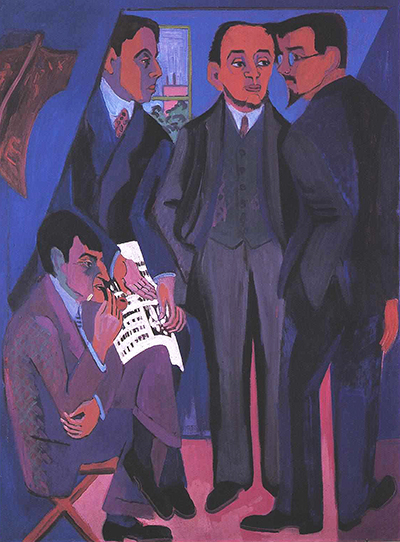Expressionism may never have happened were it not for the formation of the Die Brücke art movement in Dresden, 1905. The leaders of this forward-thinking artist collective included Ernst Ludwig Kirchner, Fritz Bleyl, Erich Heckel and Karl Schmidt-Rottluff.
Group of Artists, a painting by Kirchner from 1926/27 is shown to the left and depicts the four key figures of the movement, with Otto Mueller in place of Fritz Bleyl. Their shared beliefs, which were catalogued in an artist manifesto, sought to bridge the gap between traditional and academic art and what could be found in the future. Hence, they termed themselves as The Bridge, or Die Brücke in their native German. Restrictions were to be thrown aside in favour of full expression, focusing more on emotion than reproducing reality.
The Influences on the Die Brücke Movement
Many previous artistic movements in Europe had simply passed on ideas and techniques from previous generations, adding their own innovations as they went. They did not seek revolution, rather evolution but also rarely looked beyond styles relatively local to themselves. The likes of Kirchner, though, preferred to throw the net much wider with regards drawing in ideas and inspirations to drive their own work. Many members of the group held a great enthusiasm for the use of woodblocks, a technique which suggests the influence of past members of the North Renaissance, such as Albrecht Durer and Lucas Cranach. This technique was also used effectively by a number of artists from Japan as well.
In terms of colour, their balances are bold - the closest comparison can perhaps be made with traditional art from the regions of Africa and Oceania. You will also see the influence of African art on Pablo Picasso, who bridged the gap between the continent and European abstact art. The use of heavy contrasting tones was also used by Norwegian Expressionist, Edvard Munch, and you will find great similarities between his work and those of the Die Brücke movement. Additionally, contrasts have been made to the Fauvists, such as Matisse, who also chose abrupt colour schemes that would immediately strike you before you could process the precise details placed in front of you.
The Artistic Style of the Die Brücke Movement
Portraits, landscapes and scenes of city life form most of their paintings produced under this theme of "The Bridge". Detail was relatively sparse, just enough for the viewer to identify different elements of the composition, leaving portraits with a somewhat ghostly appearance. City scenes would leave you with feelings of loneliness and chaos, with the occasional central figure who would display poise and elegance. The lack of detail would ensure that long brushstrokes would be used to define form, whilst often shapes would clash rather than merge, with abrupt edges underlining the idea of this being art directly from emotion.
Primitivism appealed to this artist collective, as they also produced wooden sculptures and more simplistic styles of painting. Another interesting aspect to the four initial members of the group was that none had received academic training in their early lives, ensuring that their ideas and techniques were pure and undiluted by art academics. They believed this to be a huge positive and perhaps a sign of changing times within the art world, which they viewed as stuffy and in need of progression in line with the rest of society at that time. Any academic training would have led them down the very same path as previous artists had followed and seriously impacted their creativity as a result.




